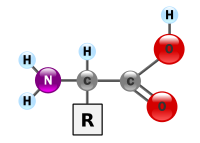
Photo from wikipedia
Abstract Dietary protein is critical for normal growth and development through its contribution of essential amino acids. In high-resource settings, protein intakes are generally adequate. Previous studies have suggested that… Click to show full abstract
Abstract Dietary protein is critical for normal growth and development through its contribution of essential amino acids. In high-resource settings, protein intakes are generally adequate. Previous studies have suggested that higher protein intakes in infancy and early childhood are associated with higher body mass index in later childhood. This analysis was performed in a subgroup of 2-year-old children (n = 468) with detailed dietary intake data (2-d weighed food record) participating in an extensively-characterised, prospective birth cohort, the Cork BASELINE Birth Cohort Study (n = 2183). Body weight and height were measured at 2- and 5-years, and indices of body composition (fat mass, fat free mass) were obtained at 5 years in a subgroup of 295 children. Total protein intake was estimated at 2-years and the contribution of animal and plant sources to total protein intake was quantified. Children were split into thirds of protein intake (as % total energy, %TE) and anthropometry and body composition at 5 years was compared across groups. The relationship between protein intake (total and animal sources) and BMI-SDS, fat mass index-SDS and fat free mass index-SDS was explored in multivariate linear regression models, adjusted for common confounders (energy intake, gestational age, duration of breastfeeding, birthweight-SDS, maternal education). Mean (SD) daily protein intake was 41.3 (11.2) g/d, representing 16.1 %TE (girls: 16.2 %TE; boys: 15.9 %TE, P = 0.202) and all children met EFSA average requirement and population reference intake thresholds. Meat (25%), cows’ milk (22%), breads (7%), yoghurt (6%), breakfast cereals (6%) and cheese (5%) were key sources of protein intake in toddlers. The majority of dietary protein intake was from animal sources (69%). Girls with high %TE from protein [mean (SD): 19.7 (2.6) %TE] were significantly heavier and taller at 5 years than their counterparts [low: 13.1 (1.4) %TE; medium: 16.0 (0.7) %TE], and had significantly higher fat free mass, fat free mass index and total body bone area (indicative of body size), but not fat mass. When adjusted for confounders in multivariate regression models, no association was observed between total protein intake and BMI-SDS, fat mass index-SDS or fat free mass index-SDS at 5 years. Children with high animal protein intakes (as %TE) had significantly higher fat free mass than their low and medium group counterparts; however, when adjusted for height and other confounders, no association was observed. Protein intakes in early childhood were associated with larger body size, but not BMI or body composition at 5-years.
Journal Title: Proceedings of the Nutrition Society
Year Published: 2020
Link to full text (if available)
Share on Social Media: Sign Up to like & get
recommendations!